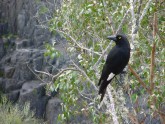You are here
Home ›Birds Behaving Badly - Pied Currawong
The 'Currawong problem' is a case of a predator getting out of control. The population of Pied Currawongs, Strepera graculina, on the east coast of Australia is believed to have increased dramatically with the creation of this favourable habitat by humans. Pied Currawongs are voracious nest predators with a strong negative influence on smaller birds in some areas.
Wide-ranging diet
Pied Currawongs have a broad diet, eating insects, fruit and vertebrates, ranging from tiny skinks to adult Spotted Turtledoves. They thrive on berries of ornamental plants, some of which have become weeds in urban bushland: one regurgitated pellet from a Pied Currawong contained over 60 privet seeds. They also eat food scraps, petfood and will feed at bird feeding stations.
Increasing numbers in cities
Historically, Pied Currawongs used to breed in the Great Dividing Range and only visit east coast cities in flocks during the autumn and winter. However, they now remain in Sydney all year round, and increasing numbers are nesting there. Cities provide an abundance of food resources, reducing the mortality of young Pied Currawongs during the winter to levels much lower than they would be in their 'natural' habitat.
Breeding and feeding…on other birds
Pied Currawongs eat more vertebrate material during the spring breeding season than they do during autumn and winter, when berries are more widely available. Many other birds breed during the spring, so the nesting seasons of small birds and their Pied Currawong predators overlap. A pair of Pied Currawong may kill about 40 broods (up to two kilograms) of small birds to raise one brood of its own.
Attempts at control
Two attempts at controlling Pied Currawongs have been made to arrest the decline of highly important bird populations:
- the removal of Pied Currawongs from Cabbage Tree Island off the coast of New South Wales led to an increase in the population of the endangered Gould's Petrel
- a partial removal of Pied Currawongs from a nature reserve in the New England district of New South Wales reduced nest predation rates by a fifth
What can be done?
Culling is not a sustainable long-term solution to the 'Currawong problem'. Currawong populations are being artificially maintained at a high level by the habitat attributes that we create in our urban environments. Reducing the quantities of exotic berry-producing plants, such as privets and Asparagus Fern, is an essential component of any actions taken to bring Pied Currawong numbers down to level where their impact on small birds is not so harmful.
References
Major, R. E. 2003. Urban currawongs. Nature Australia 27(9): 52-59
Fulton, G.R. and Ford, H.A. 2001. The Pied Currawong's role in avian nest predation: a predator removal experiment. Pacific Conserv. Biol. 7: 154-160.
Wood, K.A. 1998. Seasonal changes in diet of Pied Currawongs Strepera graculina at Wollongong, New South Wales. Emu 98: 157-170.
Bass, D.A. 1995. Contribution of introduced fruits to the winter diet of Pied Currawongs in Armidale, New South Wales. Corella 19: 127-132.
Major, R.E., Gowing, G. and Kendal, C.E. 1996. Nest predation in Australian urban environments and the role of the Pied Currawong Strepera graculina. Aust. J. Ecol. 21: 399-409.









